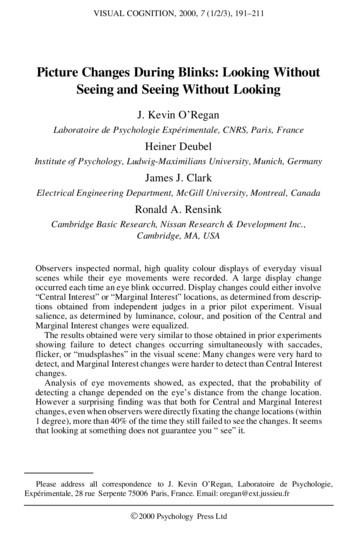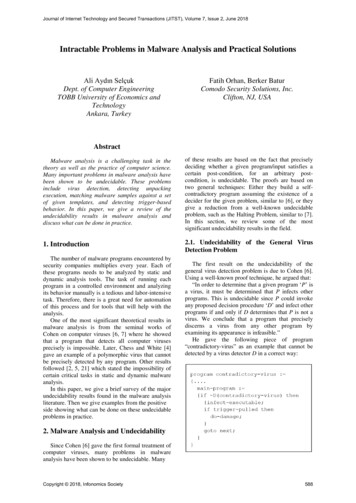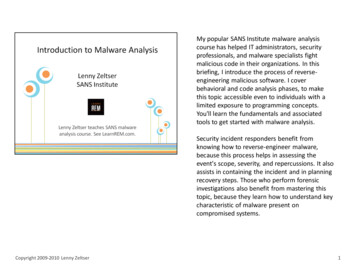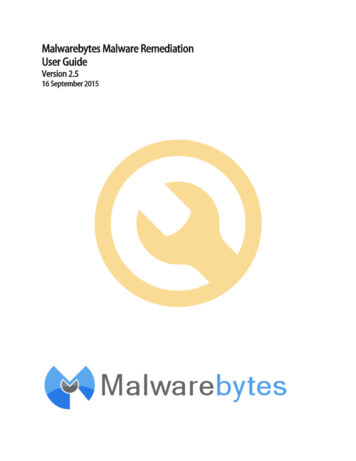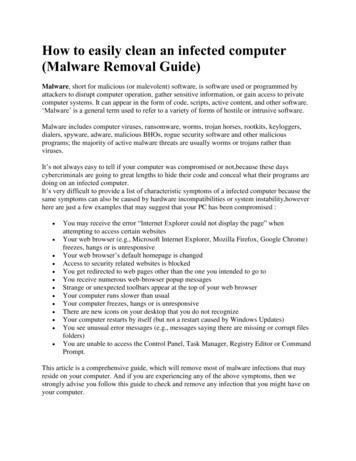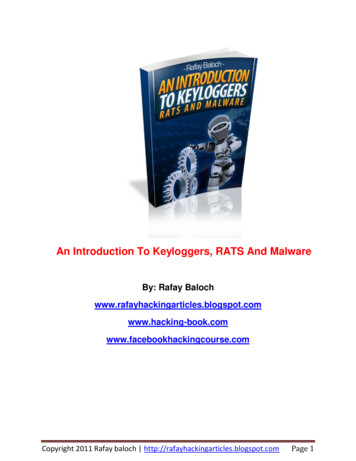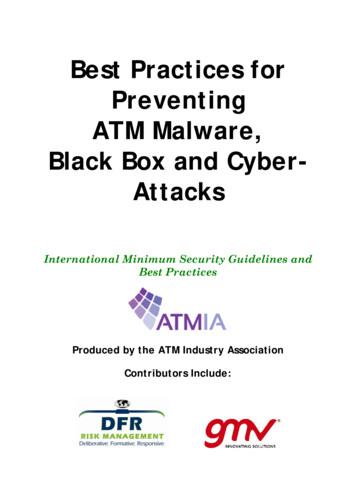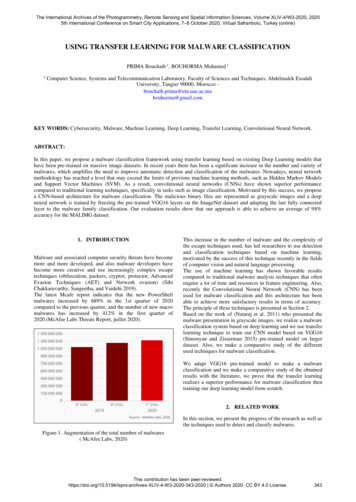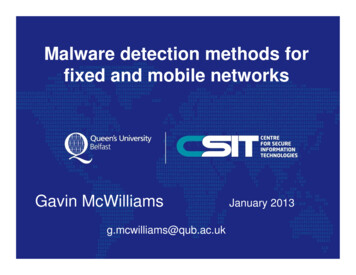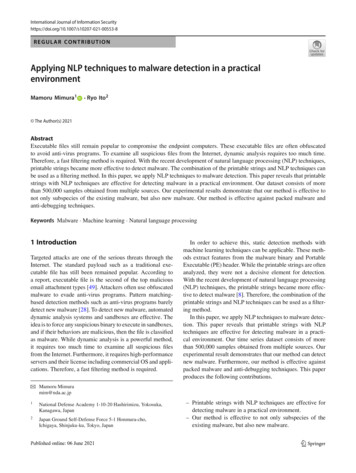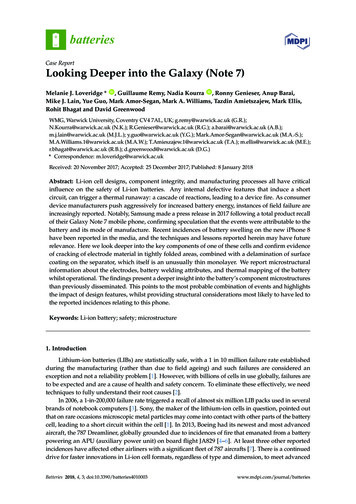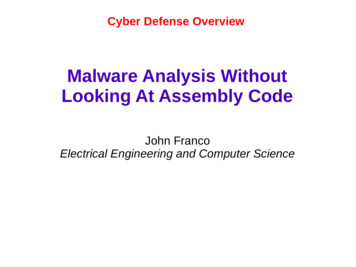
Transcription
Cyber Defense OverviewMalware Analysis WithoutLooking At Assembly CodeJohn FrancoElectrical Engineering and Computer Science
MalwareWhat:Virus: computer program, hidden in another program,plants copies of itself in other programs and usuallyperforms a malicious actionWorm: small, self-contained, self-replicating program,invades networked computers and usually performsa malicious actionTrojan Horse: seemingly useful program, has concealedinstructions which perform a malicious action whenexecuted (remotely)Spyware: installed without a user's knowledge, transmitsinformation about user activities over the InternetAdware: transmit activities to advertisersBackdoor: allows attacker in without credentialsRootkit: backdoor in a now modified OS
Malware AnalysisClasses of COTS Tools:Sniffer: monitor and analyze network trafficDisassembler: generate assembly code from binaryDebugger: allows observation of code execution as it runsDecompiler: generate readable high level code from binarySpecial Purpose: lots
Malware AnalysisGoals of malware analysis:Understand how a particular malware works so defensesagainst it can be developed- where did it come from and how did it get here?- who is the intended target?- what does the malware do?- how does the malware interact with the network?- how does the malware interact with the attacker?
Malware AnalysisTypes of malware analysis:- Static Analysis: look at and walk through code- Dynamic Analysis: look at behavior of the codeIs there a command-and-control channel?What exactly gets installed?Both types of analysis are needed to get a completepicture of what the malware is trying to do and howit may be stopped
Malware AnalysisMalware may employ one or more packers:A packer compresses code in a normal way butthe code is decompressed directly into RAM whenexecuted, it is not decompressed into a file.Packers are used to make the malware less detectableAnti-virus software may not be able to detect the malwareUnfortunately, there are hundreds of packers that can beused and the AV software can't manage that number, letalone new onesEncryption is also used – even if AV software can unpack,it probably won't be able to decrypt – anyway, no need touse packing if strong encryption is employed
Malware AnalysisMalware may employ encryption:Any significant strings in the malware are encryptedusing a custom encryption scheme. This means:1. command and control domains can be hard-coded inthe malware instead of having to be generated by themalware (such generators provide signatures)2. names of functions used by the malware are decryptedat runtime. An analyst must figure out the encryptionbefore progress can be madeCommunications to the attacker may be encrypted1. network analysis is made more difficult2. changing the encryption is easy for the attacker
EntropyWhat:Entropy is a measure of the randomness in a string of bytesAlternatively, it is the probability of predicting a character ina string from a given position in the stringIt is also known as Information DensityDefinition:Let X be an alphabet of n letters, let pi be the probabilitythat the i th letter appears in a string. Then the entropyof X isn p log pH(X) -i2ii 1Examples:Random, 4 letters: H(X) - 4*(1/4)*(-2) 2Next letter completely known: H(X) 0 ( log 1 0 )
EntropyUse in Malware Detection:Calculate entropy of sections ofa file – sections are determinedfrom the file headers (exe file).If the entropy of a section ishigh, file may be encrypted orcompressed.Distinction between sections isblurred if file is packedBinaries have large blocks of 0s,biasing the entropy – they mustbe removed from considerationCompute average and highentropy and compare againstentropy results in a database.Try: prompt binwalk -E file
EntropyUse in Malware Signatures and Detection:Roughly, there are 13 sections in an executable – 8 sectionsdue to the PE format and 5 sections due to packing algs.Experiments can produce a chromatographic-likeseparation based on percentage occurrence ofentropy greater than some threshold amount,such as that on the right – a section is indicatedas a color and the length of the color is the numberof times the section had high entropy divided bythe total number of times any section had highentropy over a large set of samples.This can be done for malware sample sets andgood sample setsGives clues: 1) whether malware is suspect2) where it might be – then use Ghidra
HashingWhat:A mapping from a long string to a small number of bytessay 20 or 40 bytes that is very hard to reverse and it ishighly improbable that two strings (from exe files) mapto the same hash valueProperties of a Cryptographic Hash:1. any bit in output should be 1 about half the time2. any output should have roughly half its bits set to 13. any two outputs should be statistically uncorrelatedAlgorithms for Cryptographic Hashing:SHA-120 bytesSHA-228 to 64 bytesSHA-328 to 64 bytesMD516 bytes
HashingExamples:On: “Now is the time for all good men to come to the aid”MD5: 651f0fb6d21c296b0aa1382fa70527d9SHA-256: a739be33806405On: “Now is the time for all good men to come to the aid”MD5: 3c8a07e525d79c591865759030fa4072SHA-256: a65a8c377d6c6cIf someone tries to modify a file that we have a goodhash for, we will be able to determine this happenedby taking a hash of the modified file and comparing
HashingExamples:On: “Now is the time for all good men to come to the aid”MD5: 651f0fb6d21c296b0aa1382fa70527d9SHA-256: a739be33806405On: “Now is the time for all good men to come to the aid”MD5: 3c8a07e525d79c591865759030fa4072SHA-256: a65a8c377d6c6cBut how well does this work when trying to see if two filesare similar? Not veryThis is what we want to do when attackers slightly changetheir software to try to evade detection via hashes
HashingHash on sections of a file to get a class signatureExamples:Use uniform sections – say 13 bytesOn: “now is the time for all good men to come to the aid”MD5: ff22fa89baea5924366fae1bd5e0On: “now is the time for all good men to come to the aid”MD5: ff22fa89baea5924366fae1bd5e0Now we need a good comparison algorithm!
HashingRolling Hash:Given: hash function that produces 4 bytesAccumulate hashes over the last n bytes in a given stringx,y,z,c,d: 4 bytes; w: array of s elementsAt any position p in the input, the state of the rolling hashwill depend only on the last 4 bytes of the file.The rolling hash function F is constructed so that it ispossible to remove the influence of one of the terms. Thus,given hash r at position p, it is possible to compute r atposition p 1 by removing the influence of byte p-3,and adding the influence of byte p 1.
HashingRolling Hash:Given: hash function that produces 4 bytesAccumulate hashes over the last n bytes in a given stringx,y,z,c,d: 4 bytes; w: array of s elementsupdate (d) {y y xy y s dx x dx x w[c mod s]w[c mod s] dc c 1z z 5z z dreturn (x y z)}
HashingRolling Hash Example:s 4,Input: “now is the time for all good men to come to the aid”nowisthedxyzc w[0] w[1] w[2] 07486a91406651613d4d521dd651068652074d521e29ar
HashingRolling Hash Example:s 4,Input: “now7is the time for all good men to come to the aid”now7isthedxyzc w[0] w[1] w[2] 074a8a91406651613d41521dd6510686520741521e29ar
Locality Sensitive HashingSpamSum:algorithmic technique that hashes similar input items into thesame "buckets" with high probability. The number of bucketsis much smaller than the universe of possible input items.Since similar items end up in the same buckets, this techniquecan be used for data clustering and nearest neighbor search.It differs from conventional hashing techniques in that hashcollisions are maximized, not minimized.
Locality Sensitive HashingElements of the Spamsum Algorithm:b compute initial block size(input);sig[0] “”; sig[1] “”;mark[0] 0; mark[1] 0; i 0;while ((d input[i ]) ! NULL) {r update(d)if (r % b b 1) {sig[0] md5sum(input[mark[0]].input[i]) % 64;mark[0] i;}if (r % (b 2) b 2 1) {sig[1] md5sum(input[mark[1]].input[i]) % 64;mark[1] i;}}signature b ":" sig[0] ":" sig[1]
Fuzzy HashingComparing Spamsum Results:Sample signature:96:RVZs5AHNMGXq08UrOaOl/7U25wTyTjH dUW557B5RE8shXMn ca9WagVQR3m46Pq:RvuGHCUS/7U25wTynH dUWP7C8sh8nJU," s.txt"Signature of similar file:96:RVZs5AHNZGXq0TUrOaOl/7U25wJTjH dUW557B5RE8shXMn pa9WagVQR3m46PiU:RvuGHLUh/7U25wJnH dUWP7C8sh8niao," s-1.txtHow to compare the two?What can be done for sig[0] to match sig[1]?cost1. a character may be removed from some signature12. a character may be inserted into some signature13. a character may be changed to a different character 34. two characters may be swapped5
Fuzzy HashingComparing Spamsum Results:Sanity check:Let signature 0 have l0 length and signature 1 have l1 length#insertions #deletions l0 - l1 #changes #swaps min (l0, l1) - a swap of two meansneither should be changedEdit Distance:E #insertions #deletions 3#changes 5#swapsSimilarity Score:M 100 (1 – E/(l0 l1))Two identical files: E 0, M 100Two same size sigs, all characters different: E 3*l0, M -50
Fuzzy HashingUses:Identify files that are not identical but close- identify malware variants by matching to knownmalware samplesTruncated files can be matched to their originals- files missing headers and not viewable can bematched to known filesFile containing pages, each of which is truncated
Malware AnalysisMalware can sometimes be identified by strings it contains:Malware may use mutex objects so that it will not re-infectan already infected machineFor a list of mutex objects seehttp://hexacorn.com/examples/2014-12-24 santas bag of mutants.txtAlso: tHowever, the mutex may be computed from some informationthat is specific to the machine it is running on such asthe product ID. Thus, the mutex may be different on differentmachines and cannot be used to identify the malwareStrings can reveal some things about the malware:http strings may be used to leak information to secure-are-query-strings-over-https/A collection of strings may reveal a password guesserA string may reveal the place of origin of the malware
Yara:Malware AnalysisIdentify and classify malware based on usual and unusualconditionsWrite rules:rule BadBoy {strings: a "win.exe" b "http://foo.com/badfile1.exe" c "http://bar.com/badfile2.exe"condition: a and ( b or c)}files or processes containing the string win.exeand any of the two URLs must be reported as BadBoyRules: a-generator.net/ Yara online rule ysis/2013/10/using-yara-to-attribute-malware/
Rootkits:Malware Analysiscracker installs rootkit after obtaining user-level access,either by exploiting a vulnerability or cracking a passwordallows attacker to mask intrusion and gain root or privilegedaccess to one computer or other machines on the networkrootkits have been known to come from seemingly innocentDRM components on a SONY audio CD!rootkits can be exploited by any malware!!Detection:1. look for telltale strings2. look for calls to library functions that are hidden fromthe Windows API, Master File Table, and directory index3. look for library calls that are redirected to other functions,or load device driversRemoval:Better off just reinstalling clean OS
Malware AnalysisRootkit detection in ubuntu:rkhunter -c:MD5 hash comparelook for default files used by rootkitswrong file permissions for binarieslook for suspected strings in Loadable Kernel Module &and Kernel Load moduleslook for hidden filesOther:* Examine log files for connections from unusual locations* Look for setuid and setgid files (especially setuid root files)find / -user root -perm -4000 -printfind / -group kmem -perm -2000 -print* Check whether system binaries have been altered.* Examine all the files that are run by 'cron' and 'at.'* Check for unauthorized services.* Examine the /etc/passwd file on the system* Check system and network config files* Look for unusual or hidden files
Malware AnalysisBackdoor:undocumented portal that allows someone, say admin,to access the OS by bypassing the usual credential checkstraditional backdoor: can be accessed by anyoneasymmetric backdoor: can only be accessed by the plantercannot be detected (for the most part)kleptographic attack: uses asymmetric encryption toinstall a cryptographic OpenSSL RSA Backdoor: experimental backdoor plantedIn RSA key generation (chap 10 ewbook.htmlRemoval:forget removal – just reinstall OS
Malware AnalysisVirus:Feature extraction and classification lware-signatures-in-a-short-time
Malware Analysis Malware may employ encryption: Any significant strings in the malware are encrypted using a custom encryption scheme. This means: 1. command and control domains can be hard-coded in the malware instead of having to be generated by the malware (such generators provide signatures) 2. names
